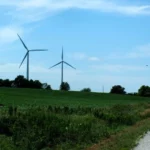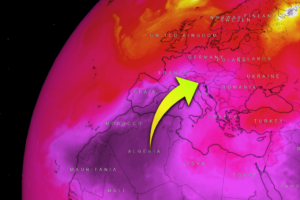EU countries have agreed to almost double their renewable energy output by 2030.
The provisional agreement means that the EU must raise the share of renewable energy in its overall energy consumption to 42.5 per cent before the end of the decade.
This is a compromise between the 45 per cent tabled by the European Parliament in the wake of Russia’s invasion of Ukraine and the 40 per cent target supported by the majority of member states. It is around 10 per cent higher than the current target.
Countries are encouraged to top up their targets by 2.5 per cent to reach 45 per cent but this part is not legally binding. Some have criticised the EU for not going far enough.
“By making 2.5 per cent of that target aspirational, [the EU] has failed to fully seize this opportunity to strengthen energy security and achieve climate goals,” says Sarah Brown, Europe programme lead at clean energy think tank Ember.
“It is now critical that Member States take ambitious action to strive for the full target to reap the benefits of Europe’s energy transition.”
In 2021, renewable energy represented 21.8 per cent of energy consumed in the EU, according to Eurostat.
The deal is part of the Renewable Energy Directive (RED) agreed on Thursday 30 March. The directive lays out the EU’s path to achieving a 55 per cent reduction in greenhouse gas emissions by 2030 – a policy known as ‘Fit for 55’.
It will also help the bloc achieve energy security and increase its competitiveness in the renewables market.
Here’s how it will be achieved and what it means for EU countries.
Nuclear power is recognised as ‘neither green nor fossil fuel’
Nuclear power became a key sticking point in reaching the deal. In a number of EU member states, it provides a high percentage of the energy they consume.
But in the early hours of Thursday morning, the bloc was still debating whether hydrogen produced using low-carbon nuclear should be included in renewable fuel targets.
France led the call for nuclear-derived hydrogen to be included. Others, including Germany and Spain, opposed this arguing that it would damage efforts to curb climate change.
Ultimately, they came to an agreement on labelling nuclear hydrogen as ‘low carbon’ rather than green.
The EU’s Renewable Energy Directive (RED) now recognises “the specific role of nuclear power, which is neither green nor fossil,” tweets French MEP Pascal Canfin, chair of the Parliament’s Environment Committee.
Transport is also included in the RED. Member states are being given the choice between two options.
Either a minimum of 29 per cent of the sector’s energy consumption must come from renewables. Or they can reduce greenhouse gas intensity – the ratio of emissions to economic output – by 14.5 per cent. Renewable energy, biofuels and nuclear energy have lower emission intensities than fossil fuels.
The option to curb greenhouse gas intensity is being seen as an allowance for countries like France that already have a low-carbon energy mix.
In the industry section, the deal calls for 42 per cent of hydrogen to come from renewable fuels by 2030 and 60 per cent by 2035.
However, these goals can be reduced if member states go beyond their overall decarbonisation goals or if their consumption of fossil fuel-derived hydrogen is low. This is another nod to France and other countries that rely on nuclear power.
Stronger sustainability criteria for bioenergy
Bioenergy comes from biomass – recently living organic materials such as plants, wood, manure and household waste.
Countries like Sweden and Finland rely heavily on biomass as a renewable energy source. Germany, too, has turned to bioenergy in recent months to reduce its dependence on Russian gas.
Last September, the European Parliament voted to reduce which types of wood counted as renewable but did not completely phase out woody biomass as a form of renewable energy.
The RED upholds this while strengthening the sustainability criteria for biomass used for energy. It says this will reduce the risk of unsustainable bioenergy production and ensure biomass is used in the most environmental way possible.
However, opponents say bioenergy drives deforestation and requires land to be converted for agriculture. Burning wood pellets also produces carbon emissions.
“The EU had an opportunity to end the scandal of burning ever more trees for energy, by limiting the amount of primary woody biomass that can be considered as renewable energy,” says Juliette Lunel, climate and land use policy officer at WWF Europe.
“But instead, and despite all scientific evidence, the negotiators endorsed a position that will accelerate climate change in the name of climate action.”
Faster approval for wind and solar projects
Currently, red tape is slowing the approval of new renewable power facilities across the EU.
The RED addresses this by introducing accelerated and simplified procedures to get permits for renewable energy projects. The new rules will apply to dedicated ‘renewables acceleration areas’ designated by each country.
It is hoped that this will fast-track the deployment of renewable energies and improve energy security.
Renewable energy deployment will also be deemed of ‘overriding public interest’. This will limit the grounds for legal objections to new projects and lessen regulatory burdens.
Countries such as Germany have already begun unravelling the bureaucracy hampering renewables by proposing measures for simplifying licensing and fast-tracking approval processes.
Source : Euro News











Add Comment